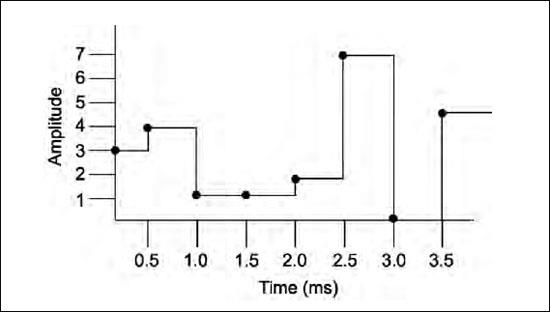WavesPutting Information on Electromagnetic Waves |
What is the difference between analog and digital signals? |
All transmitters create what is called a carrier wave at a specific frequency. For licensed commercial broadcasters, the Federal Communications Commission (FCC) assigns the frequency. The carrier wave transmits no information. For information to be carried, some property of the carrier wave must be changed. The earliest methods of radio broadcasting used analog signals from a source like a microphone. Sound striking a microphone produces a varying voltage output. That is, the output of a microphone has the same shape of the amplitude of the sound wave that strikes it. The smooth graph below represents an analog signal from a microphone.
To create a digital signal the analog output of the microphone is converted into a series of numbers. For example, consider the graph above. Suppose the signal is “sampled” every 2,000 times each second. That is, the voltage is recorded each 0.5 millisecond. The dots show the results of the sampling. Voltage can be in only whole numbers. The series of numbers representing the waveform would then be those shown in the table.
Next the voltages are converted into binary digits, a series of 0s and 1s. The table on the right shows the conversion to binary for numbers 0 through 7. The binary digits reading left to right represent the numbers 4, 2, and 1. Thus 5 = 4 1 or 101.
Now the binary numbers are converted into a series of voltages to be sent to the transmitter. One method is called Pulse Width Modulation or PWM. A narrow pulse represents a 0, a wider pulse represents 1. For example, the first four samples would produce the following wave train:
The receiver knows that three bits should be converted into a number. If the receiver is to convert the signal back to analog, then that number determines the amplitude of the analog wave.
Does this look like the original analog signal? No way! Note that there are two problems. First, the “wiggles” in the wave are missing. Second, with only 8 choices of voltages, the vertical resolution is too small. To make a more accurate conversion you need to sample the wave more often, at least every 0.1 millisecond and to allow more than 8 voltage choices; 32 or more would be better. To obtain the quality of sound in a CD the sampling interval is 22 μs (22 microseconds) and there are at least 4,096 voltage choices.

